How do you create an effective Instagram content strategy in 2023?
Unlock the potential of your brand in 2023 with the essential Instagram strategy guide. Learn how to create a winning online presence and maximize your reach on the world's most popular social media platform.
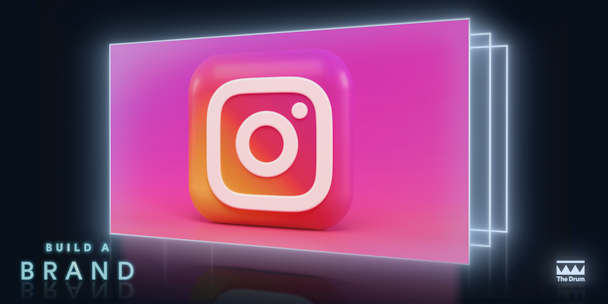
Creating an Instagram content strategy / Unsplash
Instagram is top of the line for brand awareness and has become a powerful marketing tool for brands to reach consumers in a very non-traditional way. Primarily known as visual platform, it’s unique way of bringing content to users has essentially pushed Instagram to the top of the social media channels. While the platform isn’t new, it is continually changing and adding new features, so many brands ask:
What is an effective content strategy for Instagram?
In short, it’s the gameplan you create for optimizing your Instagram channel so you can get big returns. Whether those returns are increased sales, higher brand awareness, or followers, a well-planned content strategy is a critical component. Read on to learn important tips on building an effective Instagram content strategy.
Table of Contents
- Conduct a content audit of your instagram channel
- Determine and find your Instagram audience
- Content type that works best on Instagram for businesses/brands
- Create a content calendar
- Clarify your goals for Instagram
- Plan your visual aesthetic, voice, and brand representation
- Learn the basics of Instagram
- Discover Instagram tools
- Strategize your hashtag and keyword strategies
- Final tips
- Instagram glossary
Conduct a content audit of your Instagram channel
If your brand already has an active Instagram channel it’s time to take stock. Take note of what type of content you are producing and what gets the most engagement. You may be leaving money and followers on the table, so it’s important to find out where your content gaps are and how you can fix them. Here are five areas to tackle when conducting an audit:
Content – To tackle your content audit, first check your Instagram analytics to see which of your posts have the most engagement and which have performed poorly. There are third-party tools to help with this, such as Buzzsumo and Hootsuite. Other parts of your post such as hashtags, CTAs, and captions will need to be evaluated to make sure you are using rich language, keywords, and effective descriptions.
Followers – Find out which of your followers are actual people, versus fake accounts. Fake followers can distort your data and lower your engagement rates. There are tools available such as Social Audit Pro and FakeCheck.co to help you sort and remove false accounts.
Profile – Your profile page needs to tell your entire story in one glance. Make sure you have great visual layout as well as photos that encapsulate your brand. Colors, bio photo, and especially your bio are all valuable real estate that should grab the attention of users and make them want to learn more. A bio should convey your brand personality and include:
- a strong call to action
- link to your website (customize link to be shorter with bit.ly)
- line breaks and emojis
- keywords
Calendar – Analyze your content calendar as far as what you are posting and when. Certain days and times of day are more profitable for views and engagement, so it’s important to check what are the best posting windows for your industry.
Behavior – Your followers’ behavior on your posts is very important, but your behavior is equally essential. Are you responding to comments and DMs? Are you interacting with followers on their pages? Are you interacting with influencers who could have an impact on your brand? Instagram is about community so it’s important that you immerse yourself to reap the benefits.
Determining and finding your Instagram audience
Zeroing in on your ideal audience is crucial to your Instagram success. Without active, engaged followers your platform will sit dead in the water, which is why you have to get to know them as people first, buyers later. A couple of things you should know a head of time:
- Always make sure that Instagram is one of your ideal customers’ preferred channels before you invest time and money into a long-term strategy.
- Intimately know your buyers’ shopping habits. If they prefer website purchases, then links to your website are key, if they are impulse buyers then ‘buy now’ options are great for your Instagram channel.
Once you know your ideal audience, it makes it easier for your brand to create content that speaks directly to consumers instead of merely focusing on creating loud, attention inducing content. Smart, simple, and direct posts easily hit the bullseye.
1. Work with your current buyer personas. As a brand, you certainly know who your intended audience is, most likely from research. Take this research and get detailed with who they are, shopping habits, leisure activities, likes and dislikes, pain points, and communication preferences. This is of course in addition to normal demographics such as age, gender, income, education, and the like. These rich details will help shape what your content looks like, sounds like, and the emotions it induces.
If you need help with your personas or would like a CMS to help manage them, here are some tools to check out:
2. Get a little sneaky and spy on your competitors’ channels with a competitor analysis.
- What type of content are they posting?
- What is their follower engagement like?
- What types of posts get the most engagement?
- Are buyers making on the spot purchases or being sent elsewhere?
- What level of influencers are they utilizing?
- How is their influencer engagement?
- Is there target audience the same or different than yours?
- Have they filled in audience gaps you may not have thought of?
- Who is following them and why?
- What types of promotions are they using?
- Are they collaborating with other brands? If so, with who?
This step may be a little time consuming but is valuable data for your Instagram strategy. Use this information to understand what your target audience likes to see, how they interact, and who they are.
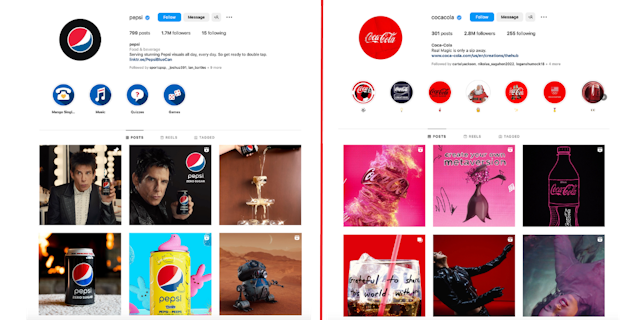
3. Analyze your current demographic data on Instagram. Instagram Insights allow you to track and measure your channel’s performance as well as giving you a view of your followers’ engagement with your posts. These metrics can also reveal data about your paid performances.
The beauty of insights is your ability to learn more about follower trends, behavior and other metrics that help you shape your content strategy. To view your insights on individual posts simply go to your profile page, tap a post you need insight on and below the image tap view insights. Keep in mind, you must have an Instagram business account for this access.
Advertisement
Type of content that work best on Instagram for brands/businesses
Content is the bread and butter of your Instagram channel so getting it right hinges on the goals you’ve set and the strategy you’ve laid out to get there. It’s important to remember that Instagram users are expecting a visual feast, as well as posts that enable a connection between themselves and your brand. Whether your content entertains, educates, inspires, or does all three, well planned consistency wins the day.
What type of content works best on Instagram for businesses/brands?
Fortunately, Instagram allows a wide variety of options for posts. Here is a list of Instagram content ideas:
- Single photos – Easily uploaded images that can be doctored with graphics.
- Gallery/Carousel posts - The combination of up to 10 images uploaded into a carousel allowing users to swipe through. A quick and effective way to share value with followers.
- Videos – Short video, usually ten minutes or less uploaded as posts.
- Live video – Live feed that allows viewers to instantly interact with your brand.
- Stories – A combination of video and photo posts that are in slideshow format. Stories are a casual way of connecting with your followers.
- Reels - Similar to TikToks, reels are short videos (15 second clips) that can incorporate audio, effects, and graphics. Reels can be at one time or in a series of clips.
- Guides – A space where you can congregate reels, videos, and posts that concern one topic. Guides are a valuable opportunity to provide value to your audience.
Here is a great Instagram content strategy example from plant-based nutrition company, @yoursuperfoods:
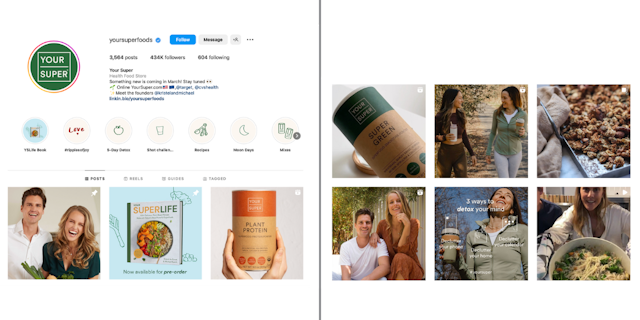
Your Super uses a variety of posts to optimize engagement such as UGC (user-generated content), promotions, behind the scenes, educational, and video.
Some important factors to remember about content are:
1. Be consistent but not boring. Don’t post the same content every time, mix it up between videos, photos, light-hearted, serious, simple, entertaining, educational, promotional, tutorials, user-generated content, and other types of content your followers will connect with.
2. Stay within a specific color palette, preferably general tones that reflect your brand. The aim is for followers to look at your profile and instantly recognize your brand.
3. Choose compelling ‘eye candy’ photos for your posts. Instagram is a highly pictorial platform and users expect to be visually stimulated.
4. Get creative in your posts but remember to maintain the same families of font, style, and colors.
5. Let your content reflect your brand personality and values. Be real, authentic, and true to who you are as a brand.
Create a content calendar
A content calendar is simply organizing your upcoming posts into an overview for the week, month, or year. This type of content structure not only helps you easily manage your posts, but also allows you a conceptual vision of your overall Instagram strategy. A content calendar should include:
- Post dates
- Post content
- Captions
- Hashtags
- Assets for post
- Paid or organic
Plan your content so it aligns with your other marketing plans. If you have specific campaigns coming up, you can parallel those with your Instagram posts to reflect off each other.
To make your life easier, using a Instagram scheduling tool will do the posting work for you. Some of the more popular tools include SocialPilot, Loomly, Tailwind, and Buffer.
Clarify your goals
Determining how Instagram plays in your overall marketing strategy will help lay a path to your goals as a brand. Whether your goal is to increase sales, awareness, or followers, the S.M.A.R.T. goal method works well here:
S – Specific
M – Measurable
A – Achievable
R – Relevant
T – Timebound
Setting these parameters will help achieve your objectives in an efficient, timely manner. Often, general social media goals can be applied to Instagram. Increasing brand awareness is easily attainable on Instagram since it is such a visual platform that features several ways to connect with audiences. Instagram’s shoppable posts allow your sales to grow to achieve long-term sales goals.
Instagram is also great for boosting community engagement if you actively engage with your followers and practice social listening, to learn what users are saying about your brand.
Focus on the visual aesthetic, voice, and brand representation
As a brand you’ve already decided on your visual and tonal representation, as well as your brand personality. It’s important that you carry these over into your Instagram channel. Consumers need to be able to instantly recognize your brand, what you offer, and who your products are intended for.
Visuals
Instagram is notorious for being a visual, topical social channel with stunning boards. It’s up to you to continue that feeling with graphics (whether photo or video) that carry the tone and mood of your brand into each post. Don’t try and reinvent the wheel but create an aesthetically pleasing profile that tells a story, captures interest, and induces the ‘feels’ from users. Please your followers and create posts that encourage engagement.
Voice
Your brand voice speaks for your company so it’s important that your Instagram channel remains true to who you are as a brand. Consistency is key here. If your brand readily uses humor then bring that over into your channel. Retain the mood of your brand’s message and loyal followers will easily find you.
Instagram is also a great place for customers to get to know the people behind the brand. Use this chance to humanize your brand and let employees or founders contribute to the voice of your company.
Storytelling also works well on Instagram since that is how most users connect. Let each post tell a micro-story whether that is through visuals, audio, or text.
A great example of brand voice and visual is @fridababy. The American parenting brand maintains their brand voice through quirky captions and on-brand visuals. They’ve even won a marketing award for a true-to-life campaign about the realities of motherhood.
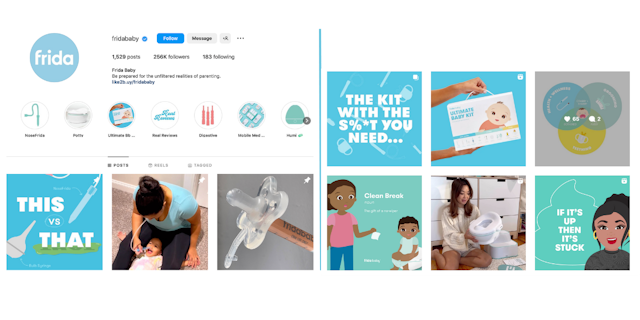
Instagram basics
Instagram algorithm
You don’t have to understand Instagram’s algorithm to have a successful channel, but a basic knowledge does help. In a nutshell, it monitors your interactions as well as your followers to enhance usability by offering up content that is more relevant to the user. As long as you are producing content that your followers will engage with and is geared toward them then you will stay in the good graces of the algorithm.
Instagram Shopping
Instagram offers a cohesive shopping base that is a set of features allowing users to shop your products through your photos and videos. Instagram also helps build your shop by walking you through the setup of your page for purchases. Here are four terms you will want to know for your shop:
- Shoppable posts – Posts that include tagged products from a brand’s Instagram shop catalog. These posts can be included in any format such as IG Stories, live broadcasts, guides, reels, or regular posts.
- Drops – IG drops alerts followers to new product launches, allowing brands to build marketing momentum.
- Product tags – Tags you attach to a product from your Instagram catalog that allows people to shop on the spot.
- Catalog – Much like a traditional catalog, this lets brands aggregate and showcase their products to followers.
Instagram Tools
Visual tools
Designing and creating posts is anything but boring with the number of tools now available. Photos and videos can be enhanced to better showcase your brand and to visually entice followers. Here are a few to check out:
- Boomerang – Instagram’s own creative app, it stitches together a burst of photos into a high-quality mini video that can be played backward or forward.
- Canva – Visual content creator that’s great for beginners yet offers a wide range of creative features.
- Instasize – Photo and video editor that includes features such as, filters, layers, overlays, touch ups, and text.
- Adobe Rush – Simple app for editing video. Intuitive and inexpensive it offers speed controls, color correction, audio, and drag-and-drop transitions.
Scheduling tools
Vital to a smoothly run page, Instagram scheduling tools will make posting, managing, and reporting so much easier. Using a tool is the best way to plan Instagram posts. Here are a few tools that your brand can put to good use:
- Sendible – A smart tool for agencies to grow their audience and reach social media goals.
- SocialBee – An AI powered management tools to help you create and post content.
- Agorapulse – Good for complicated social campaigns for any social media platform.
Advertisement
Hashtag and keyword strategies
Hashtags are the lifeblood of Instagram and help users easily connect with people, topics, or trends. In a survey of 1,000 marketers, 85% have a documented hashtag strategy. Beginning with the ‘#’ symbol, hashtags are hyperlinked to the corresponding topic or page. For example: #nissan or #purina. They help improve your chance of discovery, as well as your chance to find your target audience. Hashtags are fantastic brand awareness tools and can be used as promotional tags for new campaigns, in addition to categorizing your posts.
A post can accommodate up to 30 different hashtags, improving its chance of appearing in users’ feeds. The most effective places to attach hashtags are captions and post comments. There are a multitude of hashtag types you can create for your post, here is a list (with examples):
- Branded hashtags – #starbucks
- Geo tags – #louiesgrilledmond
- Trending – #finalfour
- Product or service – #HispanicSocietyMuseumandLibrary
- Campaign or promotional – #shareacoke
- UGC (user-generated content) – #newyorkknicksmemes
- Industry – #furnituredesign
- Community – #poetrycommunity
- Location - #londoncity
- Phrase - #loveislove
- Cultural movement – #blacklivesmatter
- Event – #fashionweek
- Holiday – #easter
- Event - #fashionweek
- Daily - #motivationmonday
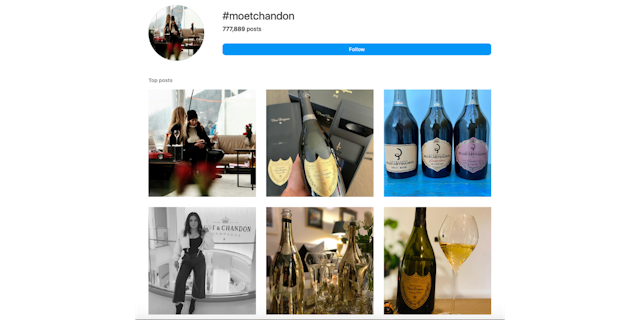
Final Tips
Creating your Instagram content strategy doesn’t have to involve precision or high-tech, but it does need a long-term, comprehensive plan to help achieve your overall brand goals. Instagram is only one cog in your marketing wheel, but it is an important one. Especially if your audience uses it to educate themselves about products. Here are a final few tips to assist in your Instagram journey:
Content (photos, videos, UGC, reposts) – Have content planned out according to your calendar as well as current events, product promotions, and other opportunities to align with your marketing goals. Plan everything from theme to photo subjects.
Posting calendar – You will need a regular posting schedule to maintain consistency and help you stay on track. Research your industry to find out what posting windows seem to work best and then play around with times until you hit the sweet spot. More engagement means your schedule is working.
Analytics and data interpretation – Consistency with analytics is also key to growing your channel. Check in weekly, at the least, to see how data is interpreting engagement and what you need to adjust.
Influencers – Research the influencers that will work best with your brand and whose values align with your company. Don’t pick someone to mold them into what you want, they need to already share your ethos. Check out the engagement rate of potential influencers’ before you sign them on the dotted line. Engaged followers are more valuable then the number of followers. Quality over quantity.
Suggested newsletters for you
Instagram glossary
If Instagram is to be a vital part of your marketing plan it’s important to understand some of the primary terms you will be seeing. This glossary is not comprehensive but will give you an idea of the terms you should know.
Algorithm – The method which Instagram decides on the content you will see in your feed. It follows user habits, follows, engagement, and preferences.
Archive – Hiding a post from your profile so only you can see it.
Audience insights – The metrics you analyze to determine follower behavior on your posts.
Bio – A short description of your account (up to 150 characters) that is situated near the top of your profile page.
Brand Ambassadors/Representatives – An influencer or other user who is paid on a long-term basis to promote a brand.
Captions – Short descriptions on each post. Captions should convey brand personality, add context to the photo/video, capture interest, and inspire followers to take action.
Contests – A post you create that encourages followers to share, like, or follow your account to be entered into a giveaway or contest.
DM (direct message) – Direct messages initiated from one user to another user.
Double tap – A method of liking a post by double tapping on the image.
Engagement rate – The percentage of your followers who have engaged with your content by commenting, liking, or sharing a post.
Exits – A metric that indicates if a user watched the entire story or left early.
Explore page – A page where Instagram aggregates posts for you based on what accounts you follow and your previous likes and comments.
Feed - A ‘newsfeed’ that acts as a landing page to view posts from those you follow, as well as hashtags you follow.
Filter – Overlays that are applied to photos to alter their appearance in some way.
Follower growth rate – The rate at which your Instagram account loses or gains followers.
Gallery posts (carousel) – Allows you to post several videos or photos (or a combination) at once, allowing users to swipe through the content.
Geotag – A geographic location tagged into a post.
Hashtags – A word or combination of letters, numbers, or symbols representing an Instagram category. Hashtags are preceded by the # symbol. Hashtags make content easily discoverable, and categorizable for users and the Instagram algorithms. Up to 30 hashtags can be used on a post. Examples are:
- #travel
- #shoplocal
- #bohostyle
- #selfcare
Handle – Your Instagram username, also known as an IG handle.
Highlights – Instagram stories that have been pinned to your profile page, showing as round icons beneath your bio.
Impressions – The number of times your post has been viewed in total (not by viewer number). In other words, five people could have viewed your post 1,000 times, so your impression number is 1,000. It doesn’t matter how many people have viewed your post, just the number of times it has been viewed.
Instagram live – An interactive feature that allows you to broadcast video or live stream to your followers in real time.
Latergram – An Instagram post about something that occurred previously, #latergram.
Nametag – A profile rich feature that lets users scan an image (user specific) to automatically pull up your profile.
Notifications – Like with any social media channel, notifications alert you to DM’s, comments, likes, and mentions.
Polls – Interactive stickers that let you ‘poll’ or ask questions to get results from followers.
Posts – The content a user uploads and posts to their profile page, reels, or stories.
Profile – A user’s main Instagram page to post photos, videos, and find your settings. You can also see who is following you, who you are following, and what you have shared with your followers. Your profile should encapsulate your brand.
Reach – There are two types of reach, organic and paid. Organic reach is achieved naturally through follower engagement, while paid reach is the size of audience that a paid post reaches.
Reels – Similar to TikToks, reels are short videos (15 second clips) that can incorporate audio, effects, and graphics. Reels can be one time or in a series of clips, and can be viewed by all users.
Repost – Sharing another user’s post on your page.
Sponsored ads – ‘Paid for’ ads that appear in users’ newsfeeds. The two types of sponsored ads are:
Paid sponsorships - Brands pay influencers to mention, promote, or use their products.
Promoted posts – Brands pay money to Instagram to help their posts reach a wider audience and be featured in feeds.
Stickers – Graphic design elements, sometimes clickable, that add interest to Instagram reels and stories.
Stories – A collection of photos or videos that appear in slideshow format, viewable only by followers or on your public profile page.
Superzoom – A feature on the Instagram app that lets you easily zoom into the center when taking a photo.
Tags/Mentions – Using a user specific hashtag on a post or comment to attract a user's attention.
Theme – The general visual aesthetic on a user’s Instagram profile (as well as posts) to reflect who they are as a brand or individual. This can include colors, filters, composition of photos, music, etc.
UGC (user-generated content) – Follower created content such as posts, reels, and stories. Typically, content that includes a brand’s/celebrity’s product or name.
For more social media tips and tricks sign up for The Drum Plus.
